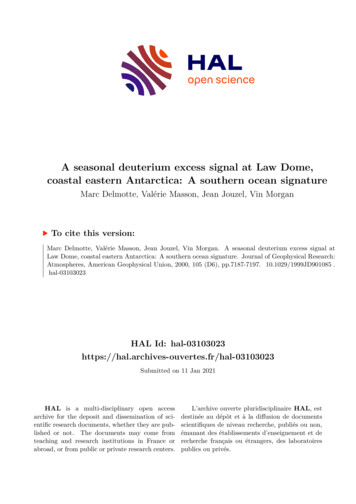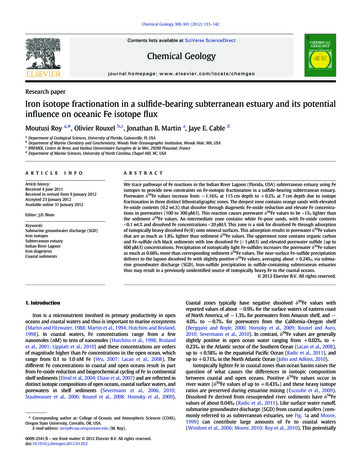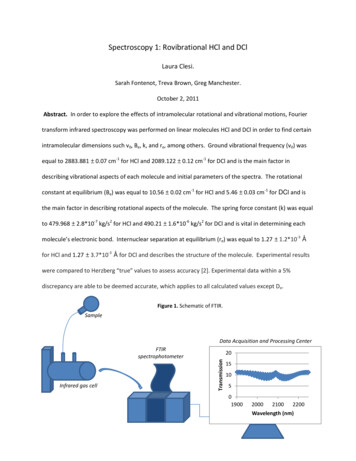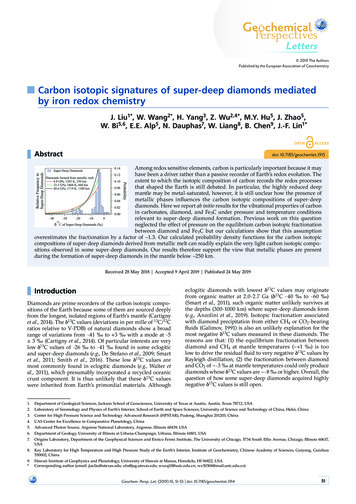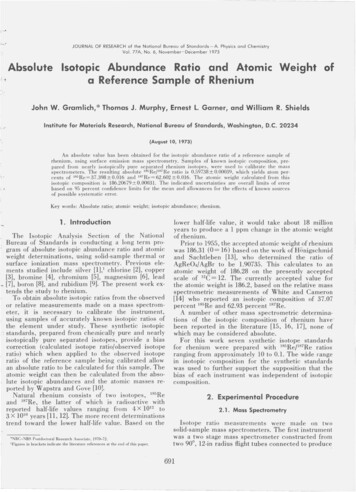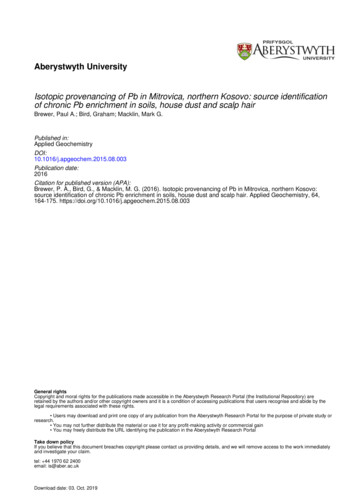
Transcription
Aberystwyth UniversityIsotopic provenancing of Pb in Mitrovica, northern Kosovo: source identificationof chronic Pb enrichment in soils, house dust and scalp hairBrewer, Paul A.; Bird, Graham; Macklin, Mark G.Published in:Applied lication date:2016Citation for published version (APA):Brewer, P. A., Bird, G., & Macklin, M. G. (2016). Isotopic provenancing of Pb in Mitrovica, northern Kosovo:source identification of chronic Pb enrichment in soils, house dust and scalp hair. Applied Geochemistry, 64,164-175. eral rightsCopyright and moral rights for the publications made accessible in the Aberystwyth Research Portal (the Institutional Repository) areretained by the authors and/or other copyright owners and it is a condition of accessing publications that users recognise and abide by thelegal requirements associated with these rights. Users may download and print one copy of any publication from the Aberystwyth Research Portal for the purpose of private study orresearch. You may not further distribute the material or use it for any profit-making activity or commercial gain You may freely distribute the URL identifying the publication in the Aberystwyth Research PortalTake down policyIf you believe that this document breaches copyright please contact us providing details, and we will remove access to the work immediatelyand investigate your claim.tel: 44 1970 62 2400email: is@aber.ac.ukDownload date: 03. Oct. 2019
Accepted ManuscriptIsotopic provenancing of Pb in Mitrovica, northern Kosovo: source identification ofchronic Pb enrichment in soils, house dust and scalp hairPaul A. Brewer, Graham Bird, Mark G. ochem.2015.08.003Reference:AG 3531To appear in:Applied GeochemistryReceived Date: 14 April 2015Revised Date:15 July 2015Accepted Date: 5 August 2015Please cite this article as: Brewer, P.A., Bird, G., Macklin, M.G., Isotopic provenancing of Pb inMitrovica, northern Kosovo: source identification of chronic Pb enrichment in soils, house dust and scalphair, Applied Geochemistry (2015), doi: 10.1016/j.apgeochem.2015.08.003.This is a PDF file of an unedited manuscript that has been accepted for publication. As a service toour customers we are providing this early version of the manuscript. The manuscript will undergocopyediting, typesetting, and review of the resulting proof before it is published in its final form. Pleasenote that during the production process errors may be discovered which could affect the content, and alllegal disclaimers that apply to the journal pertain.
1Isotopic provenancing of Pb in Mitrovica, northern Kosovo: source identification of chronic Pb2enrichment in soils, house dust and scalp hair.ACCEPTED MANUSCRIPT3456Paul A. Brewer1, Graham Bird2* and Mark G. Macklin1, 37819Department of Geography and Earth Sciences, Aberystwyth University, Aberystwyth, Ceredigion, SY23 3DB,RIPTCentre for Coastal and Catchment Research, River Basin Dynamics and Hydrology Research Group,10UK.112121YW, UK.13314222, Palmerston North, 4442, New Zealand.SCSchool of Environment, Natural Resources and Geography, Bangor University, Bangor, Gwynedd, LL5515MANUInnovative River Solutions, Institute of Agriculture and Environment, Massey University, Private Bag 1116*Corresponding author:17G. Bird: Tel.: 44 (0)1248 383222, email: g.bird@bangor.ac.uk18ACCEPTED191
20ABSTRACTACCEPTED MANUSCRIPTMitrovica, northern Kosovo, is the site of some of the highest Pb concentrations reported in human22populations; exemplified by Pb concentrations in scalp hair of up to 130 µg g-1 and widely-publicized of Pb-23related ill-health and mortality amongst internally displaced populations. High human Pb burdens are24accompanied by elevated concentrations of potentially harmful elements (PHEs) in soils and house dust25within the city, which has a long history of mining and metallurgy. In this study enrichment-levels for PHEs26in soils are quantified and compared to environmental quality guidelines and a statistically-derived27estimation of background concentration. In addition, Pb isotopes (207Pb/206Pb, 208Pb/206Pb) are used to28characterise the isotopic signatures of potential point sources of Pb and a mixing model employed to29quantify the contribution of sources to Pb present in soils, house dust, and the scalp hair of children and30young people. Pb isotopic evidence suggests that Pb in surface soils and house-dust is predominantly31sourced from historical deposition of Pb-containing aerosols from metal smelting, with lower contributions32from wind-blown dispersal of metalliferous waste. Pb present in scalp hair is interpreted as the result of33non-occupational exposure and the ingestion and/or inhalation of Pb-enriched surface soil and house dust.34This study represents one of the very few instances where this type of geochemical tracing technique has35been successfully applied to definitively identify the source of Pb present within biological samples. The36results of this study are of particular relevance to environmental management and highlight the human37health risk posed by the legacy of now inactive mining and metallurgy in addition to the challenge posed in38mitigating the risk posed by diffuse soil pollution.TEDMANUSCRIPT213940KEYWORDS: lead isotopes, mixing model, metals, soil, scalp hair4243HIGHLIGHTS:EP41 Enrichment of soils, house dust and scalp hair with potentially harmful elements45 Lead isotopes used as geochemical fingerprints to characterize PHE sources46 Mixing model quantifies the Pb inputs from anthropogenic and geogenic sources47 Legacy of smelting activity in environmental pollution48 Role of soils and house dust as a Pb source of Pb to humansACC44492
501. INTRODUCTIONACCEPTED MANUSCRIPT51The mining, smelting and processing of metal ores are widely recognised as major sources of potential53harmful elements (PHEs) within the environment (Allan, 1997; Bacon and Dinev, 2005). The consequent54dispersal of these PHEs through fluvial (Bird et al., 2008; Turner et al., 2008) and atmospheric (Sonke et al.,552008) processes often results in widespread enrichment of soils (Dennis et al., 2009; Jung and Thornton,561996), river water and river channel sediment (Bird et al., 2010a; El Khalil et al., 2008; Hutchinson and57Rothwell, 2008), floodplain sediments (Hurkamp et al., 2009; Lewin and Macklin, 1987), vegetation58(Barman et al., 1999; Fytianos et al., 2001; Zaman and Zereen, 1998) and fauna (Nannoni et al., 2011). The59impact of anthropogenic activity on modern-day PHE accumulation in the environment is significant, with60an estimated 95% of total Pb deposition (Alfonso et al., 2001; Geraldes et al., 2006), and an estimated 96-6199% of atmospheric Pb fallout (Erel et al., 1997) derived from anthropogenic sources.SCRIPT5262The deleterious effects of PHEs, especially Pb, on human health are widely recognised and have been64related to exposure from drinking water (Bird et al., 2009), edible vegetation (Komárek et al., 2007), house65dust (Bosso and Enzweiler, 2008; Spalinger et al., 2007) and atmospheric particulates (Okorie et al., 2012).66Children have been identified as being particularly susceptible to PHE uptake through behavioural67characteristics such as hand-to-mouth action (Hwang et al., 1997; Loiacono et al., 1992). This uptake route68is particularly significant in areas where families either live on, or adjacent to, land contaminated with69PHEs, or where metal smelting and reprocessing activities take place in close proximity to housing (Boisa et70al., 2013; Pelfrene et al., 2012).71TEDMANU63In the last decade lead isotopes have been increasingly used as geochemical tracers in environmental73studies (Bird, 2011; Komárek et al., 2008), and they have been shown to be a very powerful tool for74discriminating between multiple contaminant sources (e.g. Baron et al., 2009; Bird et al., 2010b; Ettler et75al., 2006; Ip et al., 2007). Lead within the environment is present as four main isotopes: 204Pb, which is a76stable, and the long-lived radiogenic isotopes 206Pb, 207Pb and 208Pb, that are the daughter products of the77decay of 238U, 235U and 232Th, respectively (Houtermann, 1946). The relative abundance of each of the four78Pb isotopes within bedrock and Pb ores will vary according to the primordial concentrations of 238U, 235U79and 232Th, and the length of the decay processes (Doe, 1970). Of particular relevance to tracing metal80dispersal pathways and fingerprinting contaminant sources, is the fact that naturally- and81anthropogenically-sourced Pb often have different and distinguishable isotopic compositions (Bacon,822002).ACCEP72833
84In Mitrovica, northern Kosovo, the release of PHEs from poorly-regulated mining and smelting industries85has resulted in the severe enrichment of Pb and other PHEs within surface soils and river water (Behrami86et al., 2008; Borgna et al., 2009; Stafilov et al., 2010). Furthermore, Pb mining and metallurgy in the87Mitrovica region, as well as poorly managed storage of mine, smelter and industrial waste (Peck, 2004), is88believed to have resulted in the most significant modern case of human Pb poisoning in Europe. High Pb89levels in blood (Wasserman et al., 2000; Wasserman et al., 1997) and hair (Runow, 2005b) have been90linked to instances of Pb-related intellectual impairment and mortality in displaced refugee populations91(Factor-Litvak et al., 1999; Lamb et al., 2008). Whilst soils in the Mitrovica urban area have been92investigated for their PHE content (Borgna et al., 2009) and the bioaccessibility of PHEs (Boisa et al., 2013),93there has been no attempt to date to definitively identify the source of Pb present in environmental and94biological media and to assess how Pb source relates to possible human exposure routes.SCRIPTACCEPTED MANUSCRIPT95In the light of this critical data gap, the aims of this study are twofold: first, to quantify PHE levels97(principally Pb) in Mitrovica from samples of (i) mine and metallurgical waste, (ii) soils and (iii) house dust.98Second, to provenance the source of Pb within environmental and biological (scalp hair) samples using Pb99isotope signatures as a geochemical tracer. Whilst Pb isotopes have been utilized to trace Pb dispersal inMANU96100riverine sediments (Ettler et al., 2006; Miller et al., 2002) and soil (e.g. Mihaljevič et al., 2006), few101attempts have been made to provenance Pb in samples of human hair (e.g. Gulson, 2008).103104TED1022. STUDY AREAMitrovica is located on the confluence of the Rivers Ibar and Sitnica in northern Kosovo. There has been106metal mining and smelting within the region for over 2000 years, however, in 1926 the Trepča mining107enterprise was founded to exploit the exclusive rights to mineral exploration at Stan Tërg to the northeast108of Mitrovica (Palairet, 2003) (Figure 1). Stan Tërg comprises a Miocene-age Pb-Zn-Ag skarn deposit in the109form of a massive to submassive lens, with occasional sulphide veins, hosted within a Palaeozoic-age host110geology (MonTec, 2007). Lead and Zn production peaked in the 1930s (62,784 t and 53,191 t, respectively)111with ore grade quality ranging between 6% (Zn) and 8% (Pb) (Sostaric et al., 2011). Ore production fell112sharply during the Second World War but then quickly recovered by the early 1950s. In the latter half of113the twentieth century combined Pb and Zn ore production steadily declined and had fallen to 10,295 t by114the start of the 1998 war in Kosovo.ACCEP105115116Metal ores were processed (via floatation) at Tuneli Pare and smelted at Zvečan (Figure 1) along with ores117from elsewhere within the region. Tailings produced from ore flotation were stored in the Zharkov Potok4
118tailings pond, whilst waste from the Zvečan smelter was stored in the Gornje Polje slag heap located119adjacent to the River Ibar (Figure 1). In 1987 a new Zn electrolysis plant opened in the Trepča Industrial120Complex in the southeast quarter of the city (Figure 1). Uncovered industrial waste generated from this121now disused plant, and from an adjacent chemical/battery factory, covers an area of approximately 30 ha122on the banks of the Sitnica River (Figure 1). In total, c. 30 M tonnes of waste from metallurgical industries123is stored in and around the Mitrovica urban area.ACCEPTED MANUSCRIPT124During the 1999 conflict in the former Yugoslavia, an 8,000 strong Roma, Ashkali and Egyptian (RAE)126community was displaced from the Roma Mahalla suburb of Mitrovica, northern Kosovo (Figure 1). A127proportion of this internally displaced population (IDP) was housed in camps at Cesmin Lug, Kablare and128Osterode in Mitrovica (Figure 1). These camps are situated between 2 km and 0.8 km downwind of the129Zveçan lead smelting complex and the Gornje Polje waste dumps. Following concerns over impacts to130human health posed by PHE levels, numerous health surveys have been conducted involving the analysis of131blood (WHO, 2004), hair (Runow, 2005), plants (Riccobono et al., 2004; Borgna et al., 2009), water132(Behrami et al., 2008) and sediment (Riccobono et al., 2004). Since 2012 the remaining RAE population has133been rehoused to redevelopments in Roma Mahalla and Bosniak Mahalla (Figure 1).MANUSCRIPT1251341353. METHODSTED1363.1. Sampling and analysis of samples138Soil, mining/industrial waste, house dust and human scalp hair samples were collected in December 2009139and 2011 from a variety of sites in Mitrovica (Figure 1). To characterize the geochemical signatures of140potential contaminant sources, samples of mine tailings, smelter waste and industrial waste (n 12) were141collected from the Zharkov Potok, Gorne Polje and Trepča Industrial Complex waste dumps. To establish142the magnitude and extent of contaminant dispersal from these sources, a total of 182 soil samples were143collected Roma Mahalla, Bosniak Mahalla, the Cesmin Lug and Osterode IDP camps and from sites across144the Mitrovica urban area. At each site up to three samples were collected with a stainless steel trowel and145Edelman soil auger from 0-10 cm (surface soil), 10-30 cm (shallow sub-surface soil) and 30-50 cm (deep146sub-surface soil). In addition, samples of house dust (n 7) were collected using a nylon brush from147occupied dwellings in the Cesmin Lug and Osterode camps and from unoccupied houses in Roma Mahalla.148Finally, to assess the uptake of metals (principally Pb) by the RAE communities, 10 samples of scalp hair149were sampled using stainless steel scissors from children and young people (aged 1-21 years) living in the150Cesmin Lug and Osterode camps.ACCEP1371515
152In the laboratory, soil and mining/industrial waste samples were air dried at room temperature,153disaggregated using a pestle and mortar and sieved through a 2 mm nylon mesh. Sub samples of the154disaggregated 2 mm fraction were digested for 1 hour in concentrated HNO3 at 100 C. Lead and Zn155concentrations were determined using a Perkin Elmer Atomic Absorption Spectrophotometer (AAS) and156As, Cd and Cu by a Thermo-Finnegan Element2 Magnetic Sector-ICP-MS (MS-ICP-MS). Samples of house157dust were digested and analysed as above after being sieved to isolate the 63 μm fraction. Analytical158precision of metal and As analyses ranged from 1 to 7%, with analytical accuracy versus two reference159materials (ABS1 [a mid-Wales soil]) and CANMET2 [a Canadian soil]) ranging from 3 to 10 % and 2.5 to 13160%, respectively.RIPTACCEPTED MANUSCRIPT161Methods for the preparation and analysis of scalp hair samples have been reported elsewhere (Boisa et al.,1632013). In short, washed hair samples were digested in 50% HNO3 under reflux and Pb concentrations164determined by Thermo-Finnegan Element2 MS-ICP-MS. Analytical precision of Pb determinations was1655.4%, whilst analytical accuracy, assessed against the NCSDC73347 reference material (Chinese human166hair), was 12%; this relatively low analytical accuracy was due to low Pb concentrations (8.8 1.1 μg g-1).167168Lead isotopes (204Pb,169mining/industrial waste and hair samples using a Thermo-Finnigan Element2 MS-ICP-MS. Samples were170analysed in triplicate in batches of 5 along with blank samples and the NIST981 reference material.171Analytical precision was found to be 0.13 % for both 206/207Pb and 208/206Pb. Analytical accuracy versus the172NIST981 standard was 0.30 % (206/207Pb) and 0.24 % (208/206Pb). Values for173interference of 201 Hg, and isotopic ratios adjusted against the NIST981 data.207Pb and208Pb) were determined in a selection of soil, house-dust,TEDPb,204Pb were corrected for theEP174206MANUSC162Statistical determination of background Pb concentration in soils176Background concentration in soils was estimated using regression analysis of % cumulative frequency177curves of log10 metal concentrations from a sample population (Davies, 1983). The lower, linear portion of178the curve (Figure 2) is seen as representing a lognormal population derived from uncontaminated samples,179and a regression equation can be derived in order to estimate background concentration based on a180number of percentile values (16th, 50th, 84th).ACC175181182Lead concentration data from all samples collected by this study, in addition to those presented by Borgna183et al. (2009) and Riccobono et al. (2004) (n 819), were converted to their log10 equivalents and the184frequency distribution established for 50 class intervals where optimum class width (log int.) is given by:1856
186 Log int. ACCEPTEDMANUSCRIPT ! "## %& '"#187Equation 1The percentage cumulative frequency distribution (F) was calculated and Sinclair’s (1974) method was189used to resolve the complex curve into its constituent populations. The resulting curves comprise a linear190lower portion, representing the ‘background’ population (B), and a complex curve, derived from samples191with above ‘background’ Pb and Zn content (A). For each point along the linear relationship (B) F was192recalculated as F’, where:F ) *100 F. 1931940112 Equation 2RIPT188Where F is the % cumulative frequency distribution and B is the percentage of the total sample number196derived containing ‘background’ concentrations. The mean and standard deviation of F’ are readily197derived, with the mean log10 concentration corresponding to 50% cumulative frequency and the anti-log is198the geometric mean (XM) of the arithmetic data. For a normally distributed population, 68% lies within 1199standard deviation so that the standard deviation derived from:201202MANU200SC1950.5 *16th percentile 84th percentile.Equation 3The antilog is the geometric deviation (SM) of the arithmetic data. The highest probable Pb or Zn204concentration for an unenriched sediment is derived from the statistical inference that only 0.14% of the205population is likely to lie beyond the range given by XM multiplied by SM3.206TED203Additional statistical analyses in this study were performed using IBM SPSS Statistics Version 20 and the208Solver Function in Microsoft Excel.210ACC209EP2074. RESULTS AND DISCUSSION2114.1. Metal concentrations in mine, smelter and industrial waste212Table 1 presents data on metal concentrations in samples taken from unconsolidated mine tailings, smelter213slag and industrial waste stored at three locations to the north and east of Mitrovica (Figure 1). In terms of214contaminant metal storage, it is estimated that the Zharkov Potok tailings pond holds approximately 9 M215tonnes of waste material with Pb and Zn concentrations up to 1500 mg kg-1 and 1400 mg kg-1, respectively.216The Gorne Polje dumps contain approximately 12 M tonnes of Pb and Zn-rich material covering 50 ha217(Frese et al., 2004) and is made up of two sedimentologically distinct waste types. Firstly a pale red, fine218sand-size material that comprises the majority of the waste material, and second, a black coarse-sand sized7
219partially-vitreous material. The former is believed to be flotation waste, whilst the latter is believed to be220smelter slag. Metal concentrations in the Gornje Polje waste dumps contain between 1700 – 82,000 mg kg-2211222tonnages, in the Zarkov Potok tailings pond there are 12,800 tonnes and 5,700 tonnes of unrecovered Pb223and Zn, respectively, and in the Gorne Polje waste dump 280,000 tonnes and 42,500 tonnes of224unrecovered Pb and Zn, respectively. At the Trepča Industrial Complex, unconsolidated particulate waste225from the Zn electrolysis and battery reprocessing plants contains 60-1100 mg kg-1 Cd, 11,500-88,000 mg kg-2261227Industrial Complex waste dumps is the fact that highly metal-contaminated material is being actively228delivered into the Sitnica River by sheet wash, gullying and bank erosion processes. In addition this229unconsolidated material is subject to wind-blown dispersal of the finer sediment fractions. The230significance of this uncontrolled contaminant dispersal is discussed in more detail below.ACCEPTED MANUSCRIPTPb and 3000 – 49,700 mg kg-1 Zn. Based upon average metal concentrations and reported wasteSCRIPTZn and 7700-13,600 mg kg-1 Pb. A particular issue of concern at both the Gornje Polje and Trepča2314.2. PHE concentrations in soils233Minimum, mean and maximum PHE concentrations in the study area are shown in Figure 3. With respect234to the entire dataset, maximum and mean concentrations are in the order of Pb Zn Cu Cd. Highest mean235and maximum concentrations are generally found in surface soils (0-10 cm) with concentrations reducing236with depth. Non-parametric significant difference analysis (Mann Whitney U Test) (Table 2) indicates that237a statistically significant difference exists between all PHE levels at 0-10 cm and those at 30-50 cm,238predominantly at α 0.01, and between 10-30 cm and 30-50 cm (at α 0.01). There is, however, no239significant difference between Pb (p 0.4400) and Cd (p 0.0980) levels between 0-10 cm and between 10-24030 cm. These data generally indicate that greatest PHE enrichment is present within upper soil profile,241importantly, the environment with which human interaction with soils will be greatest (Abrahams, 2002).TEDEP242MANU232To quantify the magnitude of enrichment, PHE concentrations in soils were evaluated using a twofold244approach. First, metal concentrations were compared with the latest guideline values developed by the245Dutch Ministry for Housing and Spatial Planning (VROM, 2000), which represent a long-established (first246used in 1962) and stringent set of quality criteria that are based upon extensive studies of both human and247eco-toxicological effects of contaminants (Table 3). Second, given that Pb is the principal contaminant of248concern in this study, a statistical approach based on that of Davies (1983) was used to quantify the249‘background’ Pb concentration in soils collected in the Mitrovica region. Previous studies of metal250enrichment in environmental media have highlighted the value and relevance of quantifying251concentrations relative to naturally-occurring ‘background’ concentrations (Hudson-Edwards et al., 1999;252Martin, 2004). Using the Davies approach, the threshold Pb concentration for uncontaminated soil (i.e.ACC2438
253background) was calculated to be 80 mg kg-1 in the Mitrovica region. This value is very close to the Dutch254target value (85 mg kg-1, Table 3) and is also in good agreement with Pb concentrations measured at depth255in a 1 m soil profiles at Roma Mahalla (Figure 4), where concentrations of Pb at 50-100 cm depth range256from 38-71 mg kg-1. The calculated background value also agrees well with metal concentrations257measured in two c. 1.5 m soil profiles to the SW of Mitrovica by Riccobono et al. (2004), with Pb258concentrations below 50 cm depth in the two profiles averaging 67 mg kg-1 and 134 mg kg-1 (Figure 4).259Taken together, these data suggest that the calculated threshold of 80 mg kg-1 is indicative of260uncontaminated soils in the Pb-mineralized region of Mitrovica. Given that mean PHE concentrations at 0-26110 cm depth were between 1.5-2.1 and 2.8-4.9 times greater than those at 10-30 cm and 30-50 cm depth,262respectively, subsequent analysis of enrichment above threshold values has focused upon data for the263upper soil layer (0-10 cm).SCRIPTACCEPTED MANUSCRIPT264There is clear evidence of elevated PHE concentrations within surface soils in the IDP camps (Figure 3).266First, maximum Cd, Cu, Pb and Zn concentrations are enriched above Dutch Intervention values by267between 1.1 and 10 times. Second, at Osterode and Cesmin Lug mean Cd (4 and 3 mg kg-1, respectively)268and Cu (71 and 129 mg kg-1, respectively) concentrations exceed the Dutch target values and mean Pb269(1784 and 1230 mg kg-1, respectively) and Zn (1490 and 2100 mg kg-1, respectively) concentrations exceed270the higher Dutch intervention values. Third, Pb concentrations in the two camps exceed the 80 mg kg-1271‘background’ concentration in all samples by between 7 and 64 times. At Bosniak Mahalla (n 20), 100% of272samples contained Pb (2450-11000 mg kg-1) and Zn (840-3780 mg kg-1) at concentrations in excess of the273Dutch intervention values. Cadmium (0.1-10 mg kg-1) and Cu (20-110 mg kg-1) at Bosniak Mahalla were274lower and exceeded Dutch intervention in 40% and 15% of samples, respectively. At Roma Mahalla, PHE275concentrations were generally lower than at Bosniak Mahalla and the IDP camps, however, Pb levels in276surface soils (26-1000 mg kg-1) were enriched above Dutch target values in 49 % of samples (n 62), with27798% of samples exceeding the less stringent Pb Target value (85 mg kg-1). Furthermore, 98% of samples at278Roma Mahalla contained Pb in excess of the calculated background concentration.ACCEPTEDMANU265279280Although PHE concentrations at Roma Mahalla, Bosniak Mahalla and the IDP camps are elevated above281Dutch environmental guideline values, the enrichment of soils especially by Pb, is widespread across the282Mitrovica municipality (Figure 3). This is supported by results from an extensive soil survey ( 800 samples)283reported by Riccobono et al. (2004) and Borgna et al. (2009), which showed that the mean Pb284concentration (973 mg kg-1) exceeded the Dutch Intervention value, and mean Cd (7 mg kg-1), Cu (56 mg kg-2851286Kosovo that included Mitrovica.) and Zn (560 mg kg-1) concentrations exceeded Dutch Target values across a 350 km2 area in northern9
287ACCEPTED MANUSCRIPT4.3. Metal concentrations in house dust289Maximum PHE concentrations were found in samples collected from the IDP camps (Table 4), with290maximum PHE concentrations in the order of Pb Zn Cu Cd. Mining and smelting activity have often been291identified as key industrial sources of contaminated house dust (Hwang et al., 1997; Bosso and Enzweiler,2922008), but wind-blown transfer of metals from contaminated soils may also act as a significant source293(Layton and Beamer, 2009). At the IDP camps, Pb concentrations in house dust (mean 4537 mg kg-1), are294an order of magnitude higher than at Roma Mahalla and are higher even than the maximum surface soil Pb295concentration found in these sites (3600 mg kg-1). To achieve Pb levels in household dust between 5500296and 5900 mg kg-1, the source material supplying the dust is most likely to have equivalent or higher297concentrations.SCRIPT2882984.4. Metal concentrations in scalp hair300Human exposure to metals can be measured in different tissues and biological fluids (Gulson, 2008),301however, hair and blood have been the most widely used biological monitors (Torrente et al., 2005). Whilst302blood tends to reflect recent exposure to metals, hair provides a record of longer-term exposure (Bencko,3031995). Lead levels measured in scalp hair samples collected from occupants of the Osterode and Cesmin304Lug IDP camps ranged between 25 and 130 mg kg-1 (Figure 5). The highest scalp hair Pb concentrations305(120 and 130 mg kg-1) were found in residents of the Cesmin Lug camp; this camp also had a higher mean306Pb concentration (90 mg kg-1) than the Osterode camp (46 mg kg-1). These concentrations are at the lower307end of the range measured previously by Runow (2005b) but are generally higher than Pb levels reported308by a number of previous studies around the world (Figure 5). Of particular significance is the fact that scalp309hair Pb levels in the children and young people living in the Osterode and Cesmin Lug camps are often310higher than published levels for adults who have been exposed to Pb via their occupational activities311(Wang et al., 2009). Given that metal levels in scalp hair are indicative of long-term exposure (Bencko,3121995), the data suggest that residents of both camps have been subject to sustained Pb exposure for a313prolonged period of time.TEDEPACC314MANU2993154.5. Isotopic fingerprinting of Pb316Potential anthropogenic sources of Pb relate primarily to metallurgical industries within the Mitrovica317region, namely; historical release of Pb-rich aerosols from the operation of the Zveçan Pb/Zn smelter,318wind-blown dispersal of Pb-rich waste from the Gornje Polje tailings dump and the dispersal of wind-blown319material from the Zarkov Potok and Zn electrolysis plant and Battery Factory waste dumps. Finally, the320influence of Pb released from the combustion of leaded petrol represents an additional, and potentially10
321longer-lasting, source of Pb. Despite being phased out from the 1990s, the continued presence in the322environment of Pb from leaded petrol combustion has been noted by a number of previous studies (Flegal323et al., 2010; Soto-Jimenez et al., 2008).ACCEPTED MANUSCRIPT324325Lead isotopic signatures (206Pb/207Pb and 208Pb/206Pb ratios) for these sources (Figure 6) indicate that these326form a linear trend with the signatures for leaded petrol and bedrock (indicative of geogenic Pb isotope
T D ACCEPTED MANUSCRIPT 2 20 ABSTRACT 21 Mitrovica, northern Kosovo, is the site of some of the highest Pb concentrations reported in human 22 populations; exemplified by Pb concentrations in scalp hair of up to 130 µg g-1 and widely-publicized of Pb- 23 related ill-health and mortality amongst internally displaced populations.
